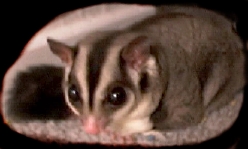
|
Taxonomic Classification
|  |
Sugar Gliders (Petaurus breviceps) are marsupials from Australia or Indonesia. They are tree dwelling, nocturnal creatures often living in groups of 20 to 40. They are soft grey animals with a black stripe running down their back, and a gliding membrane they use much as a flying squirrel does. If high enough, a sugar glider can glide as far as 150 ft. Adult gliders weigh about 120 - 135g and are about 10 - 14 inches long with about 6-8 inches of that being tail. Their tails are used for balance and steering when gliding, but not much else. Gliders have odd qualities such as opposable fingers and toes and forked genitalia (in both male and female.) They also make a wide range of sounds such as chirping, barking, chattering, crabbing and other odd sounds that are hard to describe. Gliders can live 10 to 15 years if well cared for.
Since they are social creatures, sugar gliders need lots of attention. This attention can include running around in a glider-proofed room, finger-wrestling, and riding around on your shoulder, or in your hair. If you have a single glider, you need to pay attention to it at least two hours everyday. If the sugar glider becomes lonely, it will become depressed and eventually die. They are not the kind of animal you can put in a cage, feed & forget about. If you can't always play with them everyday for at least two hours it is essential to get another sugar glider for company. Mine got depressed even though I played with him every night for more than two hours, and I had to buy a friend. He is MUCH happier now. Since they live up to 15 years, you have to be willing to take care of it for that long. You also have to make sure you have someone to take care of them when you go on vacation. If you are buying a sugar glider for your children, remember that you will have to take care of it if they lose interest. Please make sure you can handle this kind of commitment.
If you are considering getting a sugar glider, here is a website and a couple of books you should look at first:
Sugar Gliders - A Pet For You?
Sugar Gliders: A Complete Owners Manual by Caroline MacPherson
Sugar Gliders As Your New Pet by Dennis Kensley-Wood
More General Information Pages:
Pygmy Pets: Sugar Glider Quick Facts
Ruth's Sugar Glider Page: Description
University of Tasmania Profile
What is a Sugar Glider?
ISGA Caresheet: Introduction & Adoption
